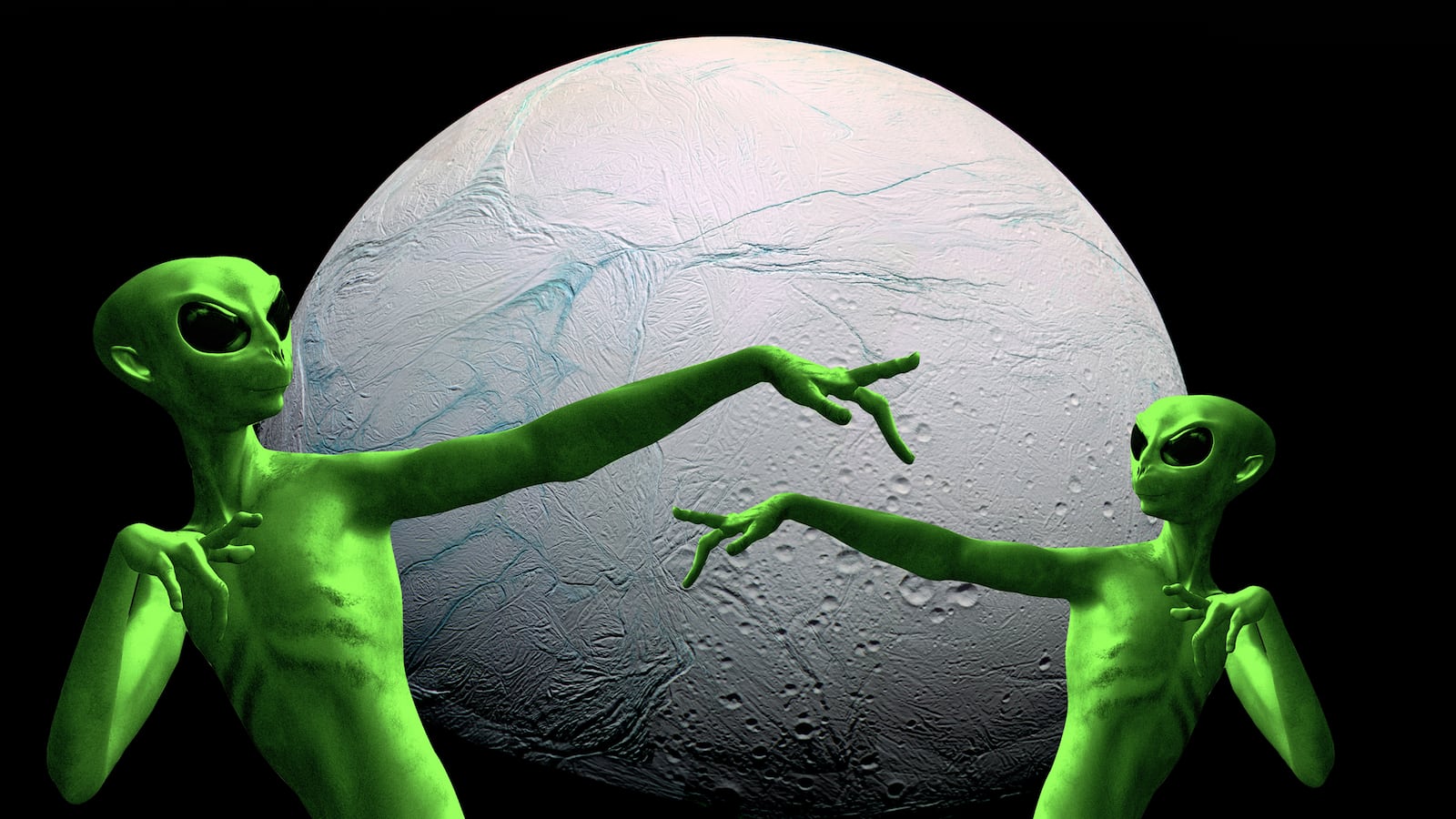Scientists increasingly believe there’s life beyond Earth. For many of them, the main question now is where we should be looking.
Our neighbor Mars, with its signs of a water-rich distant past? Europa, that icy brown moon of Jupiter that might contain a subsurface ocean? A few astronomers even point to Venus, which today is hellishly hot and dry but a billion years ago might have looked a lot like Earth.
Some scientists think we should be looking even farther—to Enceladus, a moon of Saturn. There’s growing evidence that the tiny, bright moon, just 310 miles in diameter, hides a roiling saltwater ocean. One that could support microbial life.
It’s not for no reason that NASA calls Enceladus “one of the solar system’s most scientifically interesting destinations.”
“Enceladus has become a promising lead in our search for worlds where life could exist,” the space agency stated on its website.
But getting there to make a thorough search for alien life is proving difficult. Mars is much closer. Europa is already the target of an upcoming probe mission. And Earth’s moon, with its potentially trillions of dollars worth of minerals, looms over everything as the ultimate distraction from the search for E.T.
The lure of closer and more commercial celestial bodies helps to explain why there are no missions to Enceladus in the works.
Today in scientific circles it’s uncontroversial to assert that we’re not alone in the universe. After all, there are tens of millions of galaxies that we can see from Earth. Each of those galaxies contains potentially tens of billions of planets. “Why should we be the only ones?” Martin Dominik, an astronomer at the University of St. Andrews in Scotland, asked The Daily Beast
But in centuries of searching the night sky and decades of space exploration, the human race has yet to find incontrovertible proof of alien life. Arguably the closest we’ve come was in 1976, when NASA’s Viking landers scooped up soil on the surface of Mars that fleetingly tested positive for microbes.
NASA dismissed the tests as faulty. But agency scientist Gilbert Levin insists his peers misread the data. Those tests 43 years ago were proof of life, Levin told The Daily Beast.
Humanity continues to probe Mars. A manned mission is possible in the 2030s. If there’s life on the Red Planet, we could find it soon. In the meantime, NASA is focused on Europa, one of the 79 moons of Jupiter, some 400 million miles from Earth.
Working with four decades’ worth of data from probes and telescope surveys, agency scientists in November announced they’d confirmed the presence of water under Europa’s 2,000-mile-diameter surface.
All the probes and scans since the 1970s “have amassed enough additional information about Europa to make it a high-priority target of investigation in NASA’s search for life,” the space agency stated.
“What makes this moon so alluring is the possibility that it may possess all of the ingredients necessary for life,” NASA continued. “Scientists have evidence that one of these ingredients, liquid water, is present under the icy surface and may sometimes erupt into space in huge geysers.”
Despite the $30-billion cost of the Trump administration’s rushed effort to return astronauts to Earth’s moon by 2024 in order to lay claim to the nearby satellite’s mineral wealth, NASA has also managed to book a mission to Europa—but not to Enceladus.
Europa is, “in some sense, in competition with Enceladus,” Seth Shostak, an astronomer with the California-based SETI Institute, told The Daily Beast. The SETI Institute searches for extraterrestrial life, primarily by listening for alien radio broadcasts.
The $4-billion Europa Clipper probe is slated to launch in 2025 and begin returning data from the icy moon a few years later. At present, the Clipper is only equipped for fly-bys. The idea is to get it close enough to Europa to scan the moon with sophisticated sensors.
Until recently, Congress supported adding a lander to the Clipper so it could collect samples from Europa’s surface. But the lawmaker who championed the pricey lander lost his re-election bid in 2018, leaving the lander orphaned in the appropriations process.
To gather the best data, Clipper will need to get lucky and fly through one of Europa’s occasional plumes—which could be challenging, “due to the temporal nature of the plumes and the high-radiation environment under which the samples have to be collected and the instruments have to gain information,” Dirk Schulze-Makuch, an astronomer at Technical University Berlin, previously told The Daily Beast.
Despite being roughly twice as far from Earth as Europa is and also a fraction of the Jovian moon’s size, Enceladus appears far friendlier to life as we understand it. Easier to probe, too, as its watery plumes are more frequent.
In October, NASA scientists crunching numbers from the 2005-to-2017 Cassini probe mission announced they’d found, in Enceladus’s geysers, the ingredients for amino acids—one of the basic building blocks of life. “If the conditions are right, these molecules coming from the deep ocean of Enceladus could be on the same reaction pathway as we see here on Earth,” stated Nozair Khawaja, a Free University of Berlin astronomer who led the research team.
That’s not all. “There's [another] dimension of habitability—time,” explained Marc Neveu, a scientist at NASA Goddard Space Flight Center in Maryland. Again crunching data from Cassini, Neveu and his own team estimated the age of Enceladus’ underground ocean at around a billion years—the perfect age to harbor life, according to Neveu.
“But of course, Saturn is twice the distance that Jupiter is,” Shostak pointed out. Short on cash and forced to choose between the closer, crueler ocean moon or the farther, gentler one, NASA chose the one it could get to quickest.
What this means for the search for extraterrestrial life remains to be seen. Maybe Levin is right and there’s life on Mars. Maybe we’ll find it once NASA gets over the moon and its shiny minerals and mounts a manned mission to the Red Planet.
Or maybe the Clipper probe will get to Europa before astronauts reach Mars. Maybe Clipper’s timing will be perfect and it’ll zoom right through a watery plume. In short, it’s possible we’ll find alien life somewhere else before we finally manage to organize a mission to Enceladus in the 2030s or thereabout.
Of course, it’s possible all those efforts will turn up… nothing. The search undoubtedly would continue, perhaps remotely as we scan more and more distant “exo-planets” for evidence of potentially life-supporting atmospheres.
If we do get lucky and one of Earth’s neighbors is the first to show signs of life, the result would be the same whether it’s Mars or the moons of Jupiter or Saturn.
“If it’s dead microbes under the sands of Mars, or living microbes in the oceans of Europa or Enceladus, that would at least indicate that biology isn’t rare,” Shostak explained. “The universe, we could conclude, is teeming with life.”






